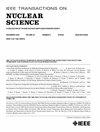Single-Event Responses of Dual- and Triple-Well Designs at the 5-nm Bulk FinFET Node
IF 1.9
3区 工程技术
Q3 ENGINEERING, ELECTRICAL & ELECTRONIC
引用次数: 0
Abstract
Triple-well designs are used to isolate substrate current and the resultant noise, across well regions, yielding excellent noise isolation in mixed-signal circuits. However, the presence of a deep-n-well significantly affects charge collection after a single-event (SE) strike. In this work, identical dual- and triple-well designs are evaluated using a wide range of particle linear-energy transfer (LET) values to elucidate underlying mechanisms affecting charge collection at advanced fin field-effect transistor (FinFET) technologies. Results show that SE cross sections for dual-well technology are significantly higher than that for triple-well technology at the 5-nm bulk FinFET node. Technology computer-aided design (TCAD) simulations are carried out to compare charge collection due to the drift process, diffusion process, and parasitic bipolar junction transistors (BJTs). Results show that the absence of a parasitic n-p-n BJT and the differences in the track length affecting the diffusion process are responsible for the differences in SE cross sections.双阱和三阱设计在5nm体FinFET节点上的单事件响应
三井设计用于隔离基片电流和由此产生的噪声,跨井区域,在混合信号电路中产生出色的噪声隔离。然而,深井的存在会显著影响单事件(SE)打击后的电荷收集。在这项工作中,使用广泛的粒子线性能量传递(LET)值来评估相同的双阱和三阱设计,以阐明影响先进鳍场效应晶体管(FinFET)技术中电荷收集的潜在机制。结果表明,在5nm块体FinFET节点上,双阱技术的SE横截面明显高于三阱技术。采用计算机辅助设计(TCAD)仿真比较了漂移过程、扩散过程和寄生双极结晶体管(BJTs)的电荷收集。结果表明,没有寄生的n-p-n BJT和影响扩散过程的径迹长度的差异是导致SE截面差异的原因。
本文章由计算机程序翻译,如有差异,请以英文原文为准。
求助全文
约1分钟内获得全文
求助全文
来源期刊

IEEE Transactions on Nuclear Science
工程技术-工程:电子与电气
CiteScore
3.70
自引率
27.80%
发文量
314
审稿时长
6.2 months
期刊介绍:
The IEEE Transactions on Nuclear Science is a publication of the IEEE Nuclear and Plasma Sciences Society. It is viewed as the primary source of technical information in many of the areas it covers. As judged by JCR impact factor, TNS consistently ranks in the top five journals in the category of Nuclear Science & Technology. It has one of the higher immediacy indices, indicating that the information it publishes is viewed as timely, and has a relatively long citation half-life, indicating that the published information also is viewed as valuable for a number of years.
The IEEE Transactions on Nuclear Science is published bimonthly. Its scope includes all aspects of the theory and application of nuclear science and engineering. It focuses on instrumentation for the detection and measurement of ionizing radiation; particle accelerators and their controls; nuclear medicine and its application; effects of radiation on materials, components, and systems; reactor instrumentation and controls; and measurement of radiation in space.
 求助内容:
求助内容: 应助结果提醒方式:
应助结果提醒方式:


